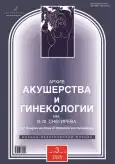Comparative study of sexual function in women with radiation-induced vaginal stenosis before and after treatment
- Authors: Gubanova E.G.1, Yashchuk A.G.1, Musin I.I.1, Battalova G.Y.1
-
Affiliations:
- Bashkir State Medical University
- Issue: Vol 12, No 3 (2025)
- Pages: 317-325
- Section: Original study articles
- Submitted: 06.03.2025
- Accepted: 11.05.2025
- Published: 17.08.2025
- URL: https://archivog.com/2313-8726/article/view/676889
- DOI: https://doi.org/10.17816/aog676889
- EDN: https://elibrary.ru/QZDALD
- ID: 676889
Cite item
Abstract
Background: One of the common complications following radical surgery and chemoradiotherapy of the pelvic organs is radiation-induced vaginal stenosis, which exerts a persistent negative impact on female sexual function and requires addressing the issue of providing assistance to women in this regard.
Aim: The work aimed to evaluate sexual satisfaction in patients with radiation-induced vaginal stenosis using the Female Sexual Function Index before and after individually tailored treatment.
Methods: The study included 25 women: 10 patients with radiation-induced vaginal stenosis treated with hyaluronic acid injections combined with dilator therapy (group 1); 5 patients who required surgical intervention—vaginal reconstruction with a Martius–Symmonds myocutaneous flap (group 2); and 10 women in the control group (group 3).
Results: The main Female Sexual Function Index domains were assessed: desire, arousal, lubrication, orgasm, satisfaction, and pain. Before treatment, the total scores in group 1 and group 2 were lower compared with the control group, with the severity of sexual dysfunction corresponding to low scores. After treatment, all domains of sexual quality of life improved in group 1, with the highest scores recorded in arousal (5.13 ± 0.29) and satisfaction (4.52 ± 0.41) domains, followed by orgasm (5.00 ± 0.43), desire (4.80 ± 0.45), lubrication (4.80 ± 0.32), and pain (4.20 ± 0.39). After treatment, the satisfaction score in group 2 was the highest, 3.92 ± 0.65, and the orgasm score was 3.84 ± 0.44. The other domains showed the following values: lubrication, 3.48 ± 0.68; desire, 3.48 ± 0.97; arousal, 3.48 ± 1.01; pain, 3.04 ± 1.30.
Conclusion: The findings may serve as an incentive for further research into the treatment of radiation-induced vaginal stenosis and, consequently, improving the sexual quality of life in women.
Full Text
About the authors
Elena G. Gubanova
Bashkir State Medical University
Author for correspondence.
Email: ekaz4ntseva@yandex.ru
ORCID iD: 0000-0003-0855-7754
SPIN-code: 8566-4281
Russian Federation, 3 Lenin st, Ufa, 450008
Alfiya G. Yashchuk
Bashkir State Medical University
Email: alfiya_galimovna@mail.ru
ORCID iD: 0000-0003-2645-1662
SPIN-code: 2607-9150
MD, Dr. Sci. (Medicine), Professor
Russian Federation, 3 Lenin st, Ufa, 450008Ilnur I. Musin
Bashkir State Medical University
Email: ilnur-musin@yandex.ru
ORCID iD: 0000-0001-5520-5845
SPIN-code: 4829-1179
MD, Dr. Sci. (Medicine), Professor of the Department
Russian Federation, 3 Lenin st, Ufa, 450008Gyuzel Yu. Battalova
Bashkir State Medical University
Email: guzel.batt@mail.ru
ORCID iD: 0000-0002-1641-9952
MD, Dr. Sci. (Medicine), Professor of the Department
Russian Federation, 3 Lenin st, Ufa, 450008References
- Kachnic LA, Bruner DW, Qureshi MM, Russo GA. Perceptions and practices regarding women's vaginal health following radiation therapy: A survey of radiation oncologists practicing in the United States. Pract Radiat Oncol. 2017;7(5):356–363. doi: 10.1016/j.prro.2017.02.003
- Bonner C, Nattress K, Anderson C, et al. Chore or priority? Barriers and facilitators affecting dilator use after pelvic radiotherapy for gynaecological cancer. Support Care Cancer. 2012;20(10):2305–2313. doi: 10.1007/s00520-011-1337-z
- Miles T, Johnson N. Vaginal dilator therapy for women receiving pelvic radiotherapy. Cochrane Database Syst Rev. 2014;2014(9):CD007291. doi: 10.1002/14651858.cd007291.pub3
- Brand A, Bull C, Cakir B. Vaginal stenosis in patients treated with radiotherapy for carcinoma of the cervix. Int J Gynecol Cancer. 2006;16(1):288–293. doi: 10.1111/j.1525-1438.2006.00348.x
- Yoshida K, Yamazaki H, Nakamura S, et al. Role of vaginal pallor reaction in predicting late vaginal stenosis after high-dose-rate brachytherapy in treatment-naive patients with cervical cancer. J Gynecologic Oncology. 2015;26(3):179–184. doi: 10.3802/jgo.2015.26.3.179
- Denton AS, Maher J. Interventions for the physical aspects of sexual dysfunction in women following pelvic radiotherapy. Cochrane Database Syst Rev. 2003;2003(1):CD003750. doi: 10.1002/14651858.CD003750
- Katz A, Njuguna E, Rakowsky E, et al. Early development of vaginal shortening during radiation therapy for endometrial or cervical cancer. Int J Gynecol Cancer. 2001;11(3):234–235. doi: 10.1046/j.1525-1438.2001.01019.x
- Brotto L, Atallah S, Johnson-Agbakwu C, et al. Psychological and interpersonal dimensions of sexual function and dysfunction. J Sex Med. 2016;13(4):538–571. doi: 10.1016/j.jsxm.2016.01.019
- Basson R, Berman J, Burnett A, et al. Report of the international consensus development conference on female sexual dysfunction: definitions and classifications. J Urol. 2000;163(3):888–893.
- Basson R. Using a different model for female sexual response to address women's problematic low sexual desire. J Sex Marital Ther. 2001;27(5):395–403. doi: 10.1080/713846827
- Stahl J, Qian J, Tien C, et al. Extended duration of dilator use beyond 1 year may reduce vaginal stenosis after intravaginal high-dose-rate brachytherapy. Support Care Cancer. 2019;27(4):1425–1433. doi: 10.1007/s00520-018-4441-5
- Owen M. International clinical guideline group. International guidelines on vaginal dilation after pelvic radiotherapy. In: National Forum of Gynaecological Oncology Nurses. Oxon, UK; 2012.
- Matos S, Lucas Rocha Cunha M, Podgaec S, et al. Consensus for vaginal stenosis prevention in patients submitted to pelvic radiotherapy. Plos One. 2019;14(8):e0221054. doi: 10.1371/journal.pone.0221054
- Necas J, Bartosikova L, Brauner P, Kolar J. Hyaluronic acid (hyaluronan): a review. Veterinarni Medicina. 2008;53(8):397–411. doi: 10.17221/1930-VETMED
- Rothenberger R, Feroz R, Hogarth N, et. al. Ideal incision and dissection for martius flap: a cadaver-based study on nerve and vascular density. American Journal of Obstetrics and Gynecology. 2024;230(4):S1225–S1226. doi: 10.1016/j.ajog.2024.02.130
- Damast S, Jeffery D, Son C, et al. Literature review of vaginal stenosis and dilator use in radiation oncology. Pract Radiat Oncol. 2019;9(6):479–491. doi: 10.1016/j.prro.2019.07.001
Supplementary files






